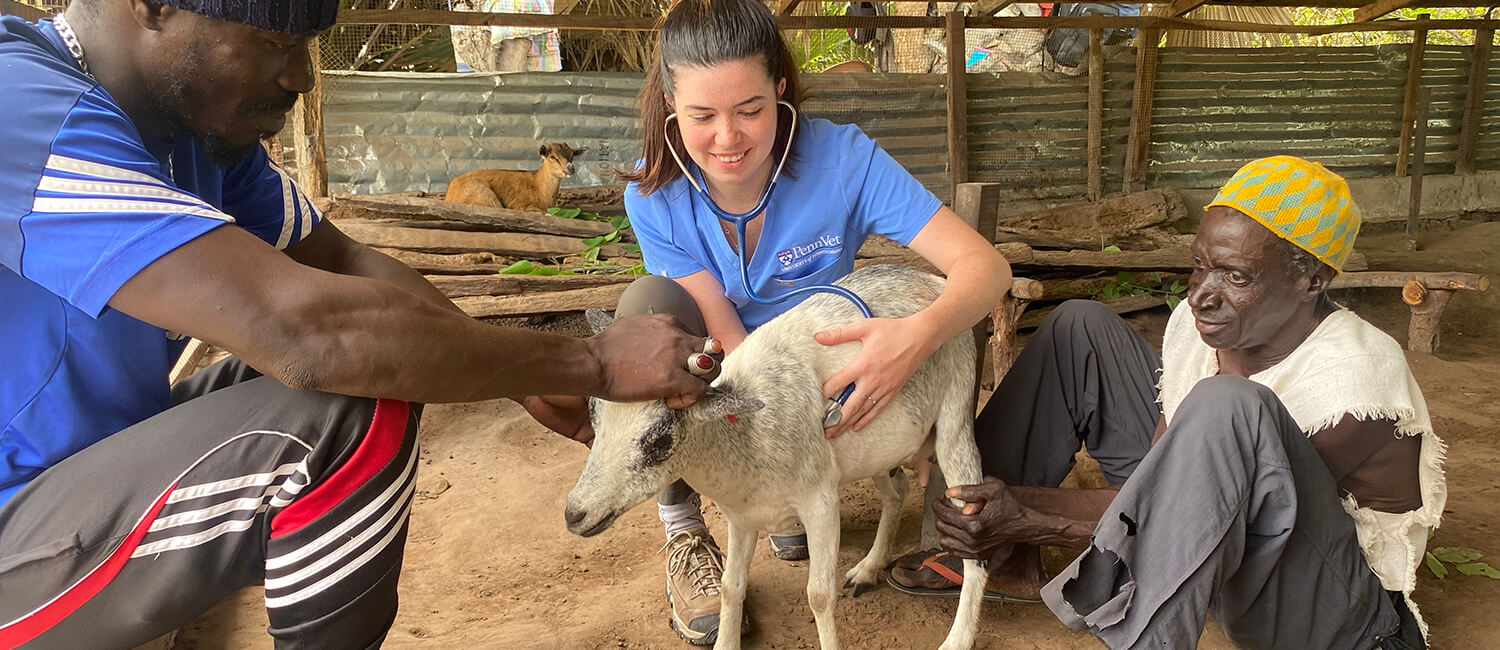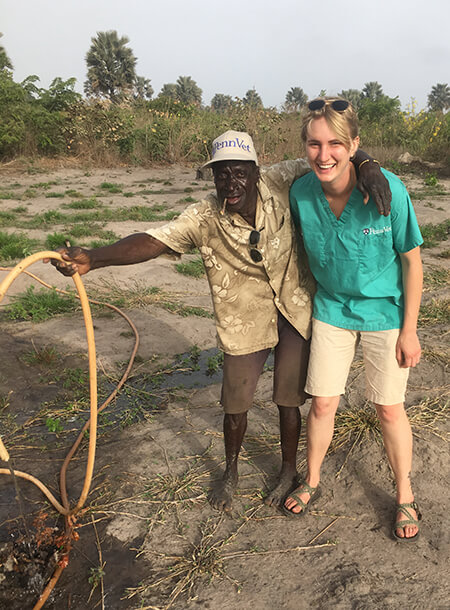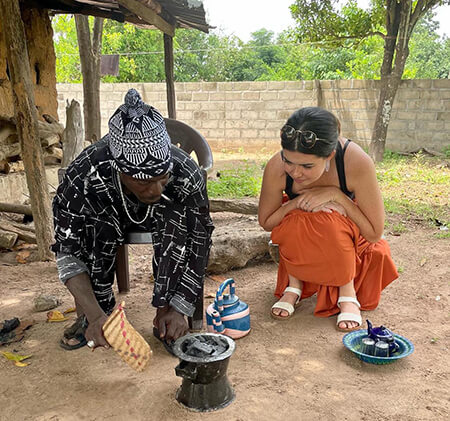 Abby Seeley (center) of Penn Vet does a health check up on a goat with the assistance of Sulay Camara (left) and Sainey Badjie (right). (Image: Courtesy of Brianna Parsons)
Abby Seeley (center) of Penn Vet does a health check up on a goat with the assistance of Sulay Camara (left) and Sainey Badjie (right). (Image: Courtesy of Brianna Parsons)
As the warm yellow sun begins its slow trek across the sky and goats forage in the shade of cinderblock buildings, Abby Seeley, a third-year student at the School of Veterinary Medicine, makes her way through the morning chores at the Gambia Goat Dairy. Upon arriving to the rabbit hutch, she wishes a pair of animals a good morning in Mandinka and gives them cabbage and potato leaves alongside the farm manager, Sulay Camara. When the rabbits have had their fill, Seeley sets off with brush in hand to clean the goats’ water buckets, checking off another task in a busy day helping tend for the farm.
Seeley, Camara, and the rabbits are part of what make up the Gambia Goat Dairy, a research farm near the Gambia’s Atlantic coast founded by Penn Vet students in 2016. The farm started with the goal of providing and processing goat dairy products for the region, but its scope has since diversified, taking up projects beyond goat rearing in an effort to model resilience for the local farming community and act as a regional hub for agricultural education. The dairy has also served as a training ground for Penn Vet students to learn to use their veterinary skills for social good. In all it does, the dairy centers the needs of the community, using local partnerships to guide every step forward.
Taking root in the Gambia
 Sainey Badjie (left) was the first person Brianna Parsons (right) hired to help run the Gambia Goat Dairy. Badjie continues to serve as watchman and caretaker for the goats. (Image: Courtesy of Brianna Parsons)
Sainey Badjie (left) was the first person Brianna Parsons (right) hired to help run the Gambia Goat Dairy. Badjie continues to serve as watchman and caretaker for the goats. (Image: Courtesy of Brianna Parsons)
The idea for the farm began in 2016, when Brianna Parsons and Corey Spies, then students at Penn Vet, were invited by a Gambian hospital CEO to start a goat dairy to provide milk for hospital patients. The pair traveled to the Gambia and began interviewing people from all sectors of society—public health experts, livestock veterinarians, business owners, farmers—to understand how a goat dairy might help meet their needs.
The interviews revealed a host of issues facing the community that extended far beyond the needs of hospital patients. More than 10% of the Gambia’s population is acutely malnourished, and over a third of the population lives on less than $1.25 a day. At the same time, while more than 70% of the labor force is involved in agriculture, agricultural practices are less productive than in wealthy nations. This means access to nutrient-rich foods like dairy products relies heavily on imports, which are prohibitively expensive for most food-insecure populations.
Parsons and Spies realized that these intersecting problems would be more readily addressed by a standalone project, so in 2016, they flew across the Atlantic once again to bring their vision to life on 10 acres in Sanyang village. They began by hosting a community seminar, where they presented their plan and listened to questions and suggestions about the project from Gambians. “We were building trust around the project, but also building ownership,” says Parsons. “I think that was probably one of the most valuable things we had done.”
The farm’s design and construction were achieved with input and labor from community members, and once the farm was ready, Parsons and Spies purchased West African Dwarf goats, a local species that thrives on native grasses and resists many diseases endemic to the region. The goats also convert feed to milk more efficiently than larger ruminants like cows, reducing both costs and environmental impact.
As the dairy came into operation, Parsons took over as director of the program and became a lecturer in sustainable agriculture at Penn Vet. She also hired Sainey Badjie, a Sanyang local who serves as watchman and caretaker for the goats, and Camara, a member of a local farming family, to help run the farm. Together, they bred the herd until they had 40 goats and began their work raising them sustainably.
While the dairy’s West African Dwarf goats are endemic to the Gambia, little research has been conducted on the species’ health and lifecycle. To fill this gap, Parsons has partnered with Seeley, who has worked in agricultural aid projects around the world, including writing a proposal for a similar dairy in Kenya. With the Gambia Goat Dairy, Seeley has been developing standards of care for the goats over the last two years.
As part of her project, she has been establishing herd vaccination protocols as well as quarantine standards to use when introducing new goats to the herd. This summer she’s working to determine what parasites infect the goats, and how to treat them.
Her efforts to develop a vaccination protocol and identify a cold chain—the infrastructure of refrigeration that prevents vaccines from spoiling—came to fruition when the goats were vaccinated this summer.
And when the dairy received more vaccines than were required, Seeley and Parsons went out to vaccinate animals at other farms in the area. The team vaccinated more than 70 animals throughout their community, and the opportunity allowed them to survey local farmers to understand their perspectives on livestock vaccination.
For Seeley, working on this project has been especially fulfilling. “It’s good to get back to doing research to benefit a community,” she says.
Guided by community
![]()
 Sulay Camara (left) stokes the coals to prepare to make Attaya as Abby Seeley (right) looks on. (Image: Courtesy of Brianna Parsons)
Sulay Camara (left) stokes the coals to prepare to make Attaya as Abby Seeley (right) looks on. (Image: Courtesy of Brianna Parsons)
Partnerships throughout the region are also fostering these community connections. Some rely on the veterinary expertise of Parsons and Penn students, as when Parsons and fourth-year vet student Bailey Carpenter hosted a workshop at a local chicken farm, teaching participants how to perform necropsies to identify cause-of-death in their flocks. Others have a more practical aim, as when Parsons agreed to buy local farmers seed for groundnuts in exchange for hay made from the chaff after harvest.
Many of these ties were built on the existing connections and expertise afforded by Camara and Badjie, but Parsons has made a concerted effort throughout the project to ensure that the dairy has responded to the needs of the broader community. These efforts have taken the shape of collaboration with local government organizations, such as Sanyang Village Community Development Committee and the Gambia Bureau of Statistics, to understand how their dairy production can address the needs of the country’s people.
“Both [Spies and I] had experience working in Africa and had seen how good intentions don’t [always] lead to good impact, and foreigners are not always best suited to come up with solutions,” says Parsons. “So, it was our goal from the very beginning to say, ‘if we’re going to do something, we need to understand the problem from the community’s lens.”
Moving forward, Parsons has begun to think of the dairy as a model for what she calls “sustainable entrepreneurial agricultural development,” serving as the flagship for international work stemming from the vet school’s new Center for Stewardship Agriculture and Food Security. To that end, she plans on finding ways that the farm can continue wrestling with the issues of poverty, food insecurity, and environmental sustainability. However, in a country where women own a majority of livestock, but are excluded from markets, and youth often choose to migrate rather than seek employment in the Gambia, Parsons has seen the need to empower women and youth. By building new partnerships with women’s empowerment organizations, Parsons will begin addressing these issues.
For now, the team keeps building community in ways large and small, whether that means getting together to disseminate agricultural knowledge—or simply to share a cup of tea.
At the end of the day, chores completed, Parsons, Carpenter, Seeley, and Camara gather on their deck for Attaya, a mix of Chinese green tea and mint prepared with sugar. Camara brings a pot of tea to boil over hot coals, strains it, and then pours the black liquid back and forth between two small crystal cups, so that a light foam forms on top of the hot beverage. Offering it to his companions, they share their drinks and watch as the sun ends its daily trek across the Gambian sky, setting the low clouds aflare with an orange glow.
The research at the Gambia Goat Dairy is funded by Rotary International District 7450, Penn Vet, Penn Global, the Rockflower Fund, and various private donors.
Abby Seeley is supported through Penn Global’s Global Research and Internship Program.